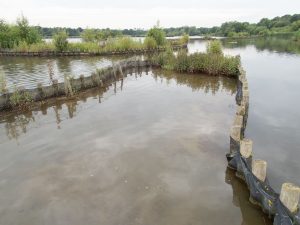The Summer heatwave continued through much of August with temperatures well above average and rainfall well below. September delivered the more expected changeable conditions and by the end of the month, the weather had turned seasonally autumnal. Thankfully, this summer’s hot weather did not produce a notable algae bloom, but instead an abundance of Lesser Pondweed, Potamogeton pusillus, and mats of this aquatic plant could be seen right across the pond’s surface. This was a very welcome development, likely ensuring that the pond’s water oxygen levels remained at a good level throughout the period and provided a boon to wildfowl.
Late Breeding News
Contrary to my last report that our breeding Pochard failed to raise any young this year, a female promptly reappeared in late July with one ‘adolescent’ young (pictured below) which I am glad to say successfully fledged.

Further good news came in August with two pairs of Great Crested Grebe successfully hatching and raising a total of three young, with a third pair suspected of nesting unsuccessfully. (Grebe pictured below)

So, the trend of late breeding at the Reserve since 2016 continues. The final tally on our breeding Tufted Ducks was an incredible 23 pairs, successfully raising between 70-80 young; probably representing well over 25% of Hampshire’s entire breeding population at the moment.
Autumn Migration
Southbound Autumn migrants were apparent from mid-July onwards. Multiple sightings were made of Green Sandpiper from mid-July into early September, with a high count of three on July 30. Other migrant waders included a Northern Lapwing frequenting Sandy Bay between August 1st – 5th and the first Common Snipe of the Autumn on August 4th. Other early movers included a count of 110 Common Swift heading over southeast on the evening of July 29th.
Passerine migrants started to pick-up in early August and the MoD Fields adjoining the Reserve’s eastern boundary proved to be particularly productive. Notable post-breeding counts included 27 Whitethroats on August 4th and a record 16 Stonechats on August 12th. Scarcer migrants observed around these fields included a Tree Pipit (pictured below) between July 29th – August 1st.

A juvenile Dartford Warbler and a Pied Flycatcher on August 12th, and a Grasshopper Warbler (illustrated below) on September 3rd, the latter particularly noteworthy.

Whinchats (illustrated below) put in several appearances in early September with two on 3rd, three on 8th and one on 10th while Goldfinches were abundant suggesting a productive breeding season, with a peak of 150 on September 8. On the Reserve itself, a vocal male Cetti’s Warbler reappeared in the Brickworks Corner on September 3rd with two reported on October 19th.

Record autumn for wildfowl
With this summer’s bloom of Lesser Pondweed right across the Pond, it turned out to be another record autumn for wildfowl and their ilk. Gadwall numbers steadily grew over the period with a July high count of 47 eclipsed by 68 on August 8th, and then a record count of 94 on October 1st. Likewise, Shoveler numbers grew as the Autumn progressed from three at the end of July to a peak count of 70 on October 22nd. Such numbers were unthinkable just a decade ago. Teal were present but continued at a low level, with the high count of 27 on September 9th, while Tufted Duck registered a respectable 45 in both September and October and Pochard peaked at five on October 11th. Scarcer wildfowl included an eclipse drake Garganey from August 4th to September 18th, single female Pintails on October 7th and 20th, and multiple reports from of Wigeon from September 2nd onwards, including four on October 20th.
Coot numbers were also elevated with a record count of 202 on September 18th. Last autumn’s Pink-footed Goose (illustrated below),

presumed to be the same individual, returned on August 30th, keeping company with Greylag Geese, flying in at dusk to roost and departing at dawn. Roosting geese numbers peaked on September 6th with 280 Canada Geese, 270 Greylag Geese and 20 Egyptian Geese present on August 1st. Single Little Grebe’s were reported in July and September and Cormorant number peaked at 24 on September 25th.
Other unexpected migrants in September included a sub-adult female Marsh Harrier, passing through west low over the Pond on the 9th and four Raven over north late in the afternoon on th 27th. Visible migration counts were limited this Autumn but did include movements of 510 (Barn) Swallow and 310 House Martin over southwest on the afternoon on September 27th, with three Sparrowhawks over with them. The only notable early Autumn roost was of 260 Jackdaws on October 3rd.
As we head into the winter months and the days grow shorter and the weather colder, expect higher roost numbers. Good birding!
William Legge
Contributing Observers: Arun Bose, Edward Butler, John Clark, Andrew Drever, N Hayward, William Legge, Sarah Slingo and Graham Stephenson.















